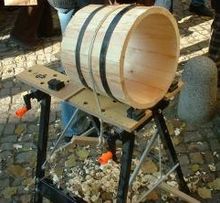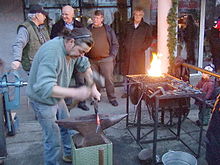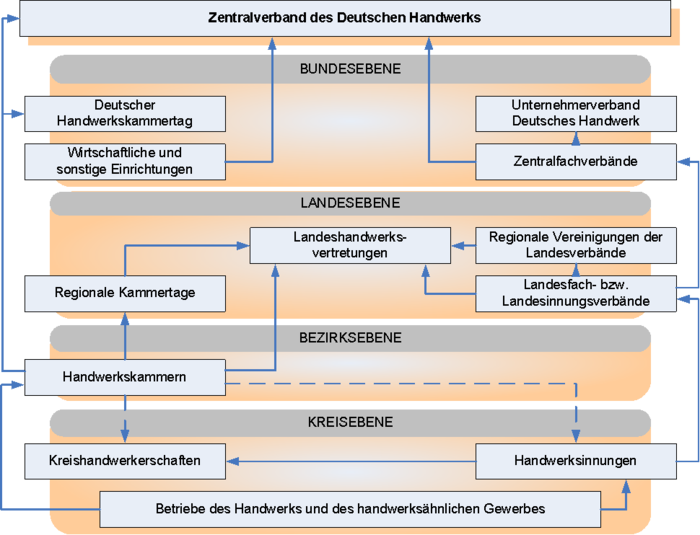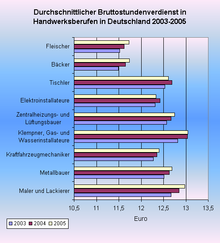Craft
![]()
Handwerker is a redirect to this article. For other meanings of the two terms Handwerker and Handwerk, see Handwerker (disambiguation). Compare also Handwerck or Hand werk.
![]()
This article or paragraph presents the situation in Germany. Help describe the situation in other countries.
Craft (from Middle High German hant-werc, a loan translation of Latin opus manuum and Ancient Greek χειρουργία cheirurgía "manual labor") refers to numerous commercial activities that manufacture products usually to order or provide services on demand. The term also refers to the entire profession. Artisanal activity is contrasted with industrial mass production. In Germany, the craft trade is bindingly regulated by the Crafts Code.

Carpenter work on a porch

Historic craft: cooperage or cooperage

Blacksmith demonstration

The German Craft Mark, official symbol of the craft until 1994
Characteristics of handicrafts as a special economic sector
The skilled crafts sector is a heterogeneous (i.e. versatile) economic sector. The variants range from industrial suppliers to craftsmen in a consumer-oriented environment, from medium-sized companies with hundreds of employees to micro-enterprises. Due to their size and the range of services they offer, craft enterprises are largely locally or regionally oriented, both in terms of sales and the labour market. Many areas of the craft economy are in direct competition with industrial production and undeclared work. The latter now accounts for more than 15 % of the gross domestic product in Germany, and the trend is rising.
Germany
Fields of activity
According to the Crafts Code, craft enterprises are active in 41 trades requiring registration, 53 trades not requiring registration and 57 trades similar to crafts. Handicrafts are defined by the areas specified in the Handicrafts Code (positive list). As a result, craft trades are predominantly restricted to markets whose opportunities for expansion in the knowledge-based economy are in some cases considered to be limited. 43.4% of the establishments in Annex A are in the metal/electrical trades, 25.8% in the construction and finishing trades, 15.6% in the health, personal care or cleaning trades, 7.2% in the wood trades, 6.7% in the food trades, 1% in the glass, paper, ceramics and other trades and less than 1% in the clothing, textiles and leather trades.
A separate topic or field of activity is the widespread craftsman's botch-up, which on the one hand means moonlighting or the work of persons without a professional basis (who therefore mess with the legally active), and on the other hand any defective execution of a craft, also called botch-up. According to guarantee obligation then a rework or another achievement compensation becomes due. The dispute about this is increasingly being dealt with by the courts, so that separate conciliation boards have been set up to settle so-called minor cases; see also Handwerkerehre (Craftsmen's honour).
Companies and employees
Almost 5 million people work in around 887,000 companies and almost 500,000 trainees are trained in the skilled crafts sector. This means that 12.8 % of all employed persons and around 31 % of all trainees in Germany currently work in the skilled crafts sector. Craft enterprises are predominantly small businesses. An analysis of the 2003 IAB Establishment Panel relating to the skilled crafts shows that 50% of the enterprises have fewer than five employees and 94% have fewer than 20 employees. In 2003, some 20% of craftsmen worked in enterprises with fewer than five employees and 35% in enterprises with more than 20 employees. The largest group of craft workers (45%) thus worked in establishments with between five and 20 employees. In 2003, the average size of a craft enterprise was 7.6 employees, only half the size of the economy as a whole. In 2009, turnover in the skilled crafts sector reached around 488 billion euros. Since the amendment of the Crafts Code in 2004 abolished the master craftsman's certificate as a prerequisite for setting up in many trades, the number of craft enterprises has increased significantly, from 846,588 in 2003 to 975,000 in 2009.
However, the economic importance of the skilled crafts sector is not only reflected in the number of businesses, the number of people employed in them and their value added. In addition, the skilled crafts sector has a special significance for regional policy: the skilled crafts enterprises are spread over the area and also contribute to growth and employment in rural regions. In structurally weak regions in particular, the availability of skilled crafts services is in turn an important location factor: the local availability of skilled crafts services (suppliers, service providers, maintenance) is not infrequently an important factor in the location decisions of companies. For private households, the local supply of craft services (e.g. food, car repair shops, etc.) is a factor that conveys the quality of life and attractiveness of the region.
Personnel structure and development
The personal qualification of employees is the decisive success factor for the innovation and competitiveness of the skilled crafts sector.
- The proportion of skilled workers in the skilled crafts sector was just under 40 % in 2003. Unskilled workers accounted for a share of only 18 %. At 17 %, white-collar workers were less frequently represented in the personnel structure in the craft trades than in the economy as a whole (35 %).
- At just under 33%, the proportion of women in 2003 was considerably lower than the overall economic average of 43.3%.
- In 2003, around 25 % of employees in the craft trades were employed in non-standard employment relationships (e.g. part-time employment).
- Employees of small enterprises participate to a strongly disproportionate extent in external continuing training measures (70.6% of large enterprises make use of offers from private continuing training providers, but only 16.2% of small enterprises).
- Wages in the skilled crafts are around 25 % lower than in industry. The gap between craft and industry is almost 1,000 euros per month for skilled workers or journeymen.
Setting up a business
The start-up rate in the skilled crafts sector was around 4.7 % in 2001 (compared with around 12 % in the economy as a whole). However, German craft enterprises have an above-average life expectancy. This is mainly due to the good preparation of young entrepreneurs "ready to start up" because of the master craftsman's certificate (major qualification certificate) and the extensive start-up advice provided by the chambers of skilled crafts.
Perspectives
The following development trends are decisive for the future of the skilled crafts sector in Germany - and Europe:
- Demographic developments will change many of the craft trades' sales markets; there are both risks (loss of customers) and opportunities (offering special services for older customers) here. At the same time, it will become increasingly difficult for the skilled crafts sector to recruit the necessary number of staff with the necessary qualifications in the competition for qualified workers.
- The innovative capacity of the skilled crafts sector is significantly weaker than that of industry. Craft innovations - in contrast to industrial innovations - relate in particular to company- and application-related new developments, solutions and processes.
- International competition will also have an increasing impact on the skilled crafts sector; here, too, there are both risks and opportunities.
Against the backdrop of these trends - which affect the various trades to varying degrees - initial and continuing vocational training is becoming more important than ever. Only with high-quality trained personnel can the skilled trades master the challenges of the future and take advantage of future opportunities. An attractive range of initial and further training is also necessary in order to attract qualified new entrants to the skilled crafts sector.
Studies on the future of the skilled crafts sector have analysed the opportunities and risks of this specific economic sector with the following results.
- Many craft enterprises can act very flexibly and dynamically in competition as SMEs.
- However, they are also often disproportionately affected by insufficient funding opportunities, a lack of skilled workers, a lack of experience and resources in the field of foreign trade and cooperation, and a lack of participation in research and development.
- In the skilled crafts sector, traditionally low qualification expectations and the required high competence profile of employees to cope with complex tasks are increasingly diverging.
- Handicraft offers excellent opportunities for identification. Crafts stand for regionality, origin, authenticity, handcrafting, transparency about materials, contents and processing methods. As a rule, craft businesses focus less on growth than on quality and balance.
- Crafts in Germany make innovative contributions to product developments. A study by Prognos AG examines the innovation contributions of the skilled crafts sector.
- Craftsmen deliver sophisticated and individual solutions under close customer contact and consideration of the customer's wishes.
- Craftsmen repair, replace and restore. In ecological and economic necessity, they are increasingly focusing on preserving what already exists.
- The skilled crafts sector is in a state of flux: Companies that offer innovative, creative and complex services are experiencing an upswing, whereas traditional companies are increasingly expecting an economic downturn.
- Due to exploding raw material and energy prices, recycling, energy efficiency, minimised use of materials and repairs are gaining in importance as business areas in the trades.
- The 35 plus generation demands forward-looking craftsmen's services. In particular, women, 80% of whom decide on the distribution of disposable household income, should be considered the main target group.
- (Older) customers are not satisfied with high-quality craftsman services alone; due to a change in values, they expect more fun and entertainment from products and services.
- Successful design of business cooperations for craft SMEs is becoming a question of survival, also in view of many blunders. Cooperativeness promises to increase targeted productivity disproportionately.
- Crafts from Germany have an excellent international reputation. Handicraft companies are increasingly finding markets in neighbouring European countries, such as Great Britain, Poland, the Netherlands and Norway, after structural deficits there have led to a lack of comparable handicraft qualifications.
- The skilled crafts sector has traditionally been interested in vocational training. Therefore, the skilled crafts also have an interest in ensuring that only well-trained craftsmen (ideally master craftsmen) are allowed to run a skilled crafts business. However, when the Crafts Code was amended, trades without a master's degree were also permitted to set up a craft enterprise. The skilled crafts have an interest in carrying out a thorough, usually three-year training in a trade.
- There is currently a heated discussion about the classification of (craft) occupations in a German qualification framework. Ultimately, the issue is the allocation of (craft) occupations to school qualifications and permeability and equality of opportunity in access to higher education also for people with vocational training and a master craftsman's qualification.
In all federal states, master craftsmen qualify to study a subject of their choice at a university at the same time as they pass the master craftsman's examination or the examination to become a designer in the skilled crafts. In Bavaria, master craftsmen have had the university entrance qualification since the winter semester 2009/2010; 387 master craftsmen enrolled at Bavarian universities in the winter semester 2009/2010. Journeymen craftsmen acquire the advanced technical college entrance qualification.
In addition, there is an opportunity for further training for craftsmen to become a "designer in the craft", where courses in drawing and representation techniques, basics of design, colour design, drafting, design, project development, materials science, work technology and model making, typography and layout, photography and documentation, history of art and design, presentation and design management, among others, must be taken. The examination takes the form of a comprehensive project. The academies for design in Germany are affiliated to the educational offers of their respective chambers of crafts and offer the one-year full-time course or the part-time 2-year course. Various funding models support craftsmen in this.
Organisational structure
The skilled crafts sector in Germany is organised as follows:
Every craft enterprise requiring a licence, the crafts not requiring a licence and crafts similar to crafts are compulsory members of the regionally responsible Chamber of Crafts (comparable to the Chamber of Industry and Commerce or the Chamber of Lawyers). The chambers form regional chambers at the level of the federal states and the German Association of Chambers of Skilled Crafts at the federal level as the umbrella organisation of the chambers of skilled crafts in Germany.
Furthermore, many craft enterprises are voluntarily organised in guilds. These guilds of a district form the district craft guilds at regional level. Guilds of the same or related trades in one or more federal states can join together to form state trade associations or state guild associations. At Land level, these associations can join together to form regional cross-trade associations as Land-wide employers' associations (often referred to as employers' or general associations). At federal level, they form the Federal Guild Associations or Central Trade Associations, which have joined together in the Unternehmerverband Deutsches Handwerk (UDH) as the umbrella organisation of employers in the skilled crafts sector in Germany.
In the federal states, the regional chambers of commerce form the regional craft days together with the entrepreneurs' or general associations as the representation of the craft sector at state level.
The 53 Chambers of Skilled Crafts and 36 central trade associations form the Central Association of German Skilled Crafts (ZDH) together with other important institutions of the skilled crafts.
The ZDH is a member of UEAPME, the European Association of Craft, Small and Medium-sized Enterprises, based in Brussels.
Other organisations in the skilled crafts sector are, for example, the Junioren des Handwerks, which specifically represents the interests of young master craftsmen and managers, and the Arbeitskreis Unternehmerfrauen im Handwerk, which represents women entrepreneurs working in the skilled crafts sector and women working in management positions in the skilled crafts sector.
The following diagram provides an overview of the German craft trade organisation:

_1968,_MiNr_553.jpg)
Stamp 1968Craft , tradition and progress

Average gross hourly earnings in some skilled crafts in Germany (2003 to 2005)
Quotes
Richard Sennett: "To do something right even when you may get nothing in return is true craftsmanship. And as I see it, only such an unselfish sense of commitment and obligation can lift people up emotionally. Otherwise, they succumb in the struggle for survival."
"A comprehensive definition [for a craftsmanship attitude (in the broader sense)] might be: doing something well for its own sake. In all areas of craft attitude, discipline and self-criticism play an important role. One is guided by certain standards, and ideally the pursuit of quality becomes an end in itself."
Search within the encyclopedia